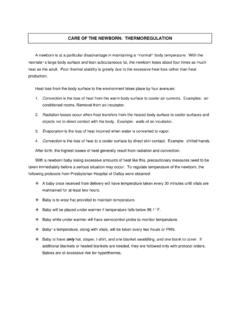Transcription of POSTPARTUM ASSESSMENT ASSESSMENT BREASTS: UTERUS
1 POSTPARTUM ASSESSMENT In POSTPARTUM , the patient is normally a well patient. Complications are possible, but for the most part the patient is a healthy individual under temporary confinement expecting to take home a healthy infant. The following are some guidelines to promote physiological psychological safety of the POSTPARTUM patient. ASSESSMENT : An ASSESSMENT on any patient is always considered to be from head to toe. In the POSTPARTUM patient, the ASSESSMENT EXPANDS to also include the following (starting from top to bottom): BREASTS: Palpate each breast for firmness, fullness, tenderness, shininess, and contour. Does the mom complain of sore nipples, are the nipples red, cracked or bleeding? Is she wearing a support bra? Encourage all moms to wear a support bra whether nursing or non-nursing. UTERUS : It is firm or is it boggy? The fundus should be firm; if not, gently massage to obtain firmness and note if excess bleeding or clots are expelled during the massage.
2 What is the fundal height? It should decrease in height by one fingerbreadth below the umbilicus each day post delivery. Nursing mothers may involute a little more quickly due to the release of oxytocin while nursing. It is best to have the mother void and then have her lie flat in bed before checking fundal height. If the fundus is above the UTERUS or displaced to the right or left, the mom may have a full bladder or retained placenta fragments. C-SECTION: If the patient had a C-Section, inspect the dressing or incision at this time noting site, redness, discharge, and approximation of the incision if uncovered. Don't forget to check for bowel sounds. LOCHIA: When examining the fundus, check the lochia for color, amount, odor, and the number of pads used. The first two to three days, lochia is bright red, similar to menses and is known as RUBRA. The next few days lochia becomes serous and more watery and is known as SEROSA.
3 By 10 to 14 days the lochia is thin and colorless and is known as ALBA. If the lochia has a foul odor, then be suspicious of an infection. The doctor should be notified of any unusual odor, excessive bleeding, or clotting. EPISIOTOMY: Inspect the incision for REEDA. (If you do not know what this is, look it up in your textbook before giving care) Also check for a hematoma. The patient may need to be medicated for discomfort. Also check the rectum at this time for hemorrhoids and initiate appropriate measures if uncomfortable to the patient. ELIMINATION: BLADDER: Is mom voiding, is so, how often and how much. Is bladder distended? Does she or did she have a catheter? If the catheter has been discontinued, what time was it? All POSTPARTUM patients should void by six hours after delivery or Foley removal. All POSTPARTUM moms should have their urine measured the first three voidings to ensure adequate emptying of the bladder.
4 These voidings should be at least 150 cc's. Remember, the mom's blood volume increased during the second and third trimester, and diuresis takes place to return to pre-pregnancy status. Frequent, small voidings may be indicative of retention or infection. This is a good time to find out if the mom is performing peri care with each use of the bathroom. If she is not, then by all means teach her according to the process of your hospital uses. BOWEL: Daily ask the patient if she has had a bowel movement. If no bowel movement by the second day, she may need a stool softener or a laxative. Encourage increase in fluid and juices along with increasing intake of fruits and vegetables. Ambulation helps too. LEGS: Check Homan's sign, and chart with cardiovascular status. TEACHING: Talk with your mom during the ASSESSMENT , and teach her the things about her care as you go along. EXAMPLE: Peri care when checking the perineum, rationale for sitz bath and peri light, use of local analgesics, hemorrhoid treatment, rationale for ambulation especially if a C-section, etc.
5 PSYCHOSOCIAL: Note mother/father infant bonding and chart . Is mom stroking the infant, talking to the infant, calling the infant affectionate names, or just looking affectionately at the infant. A lack of bonding may be noted by bottle feeding the infant in the crib, or spending time on the phone when the infant is in the room. Evaluate the mom's emotional status, explain the hormonal changes that are occurring, and that her emotions may change from high to low quickly. She may cry easily, but these changes are normal. Informing the family members of these changes helps too. POSTURAL HYPOTENSION: Caution the mom to move slowly upon sitting or getting out of bed. Assist her the first few times she is up. Stay in the bathroom or close by the first time she showers or when taking a sitz bath. Remind her NOT TO LOCK the bathroom or shower doors. Be CERTAIN your mom can reach and has been instructed in the use of the call bell in the bathroom or shower as well as her bed.
6 REMEMBER: WEAR YOUR GLOVES WHEN CHECKING A POSTPARTAL PATIENT.




